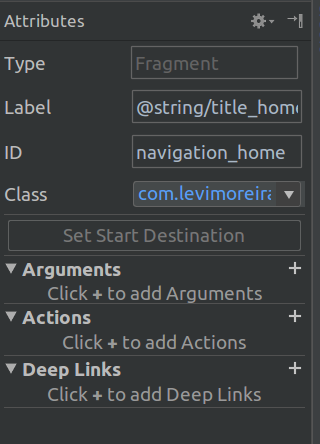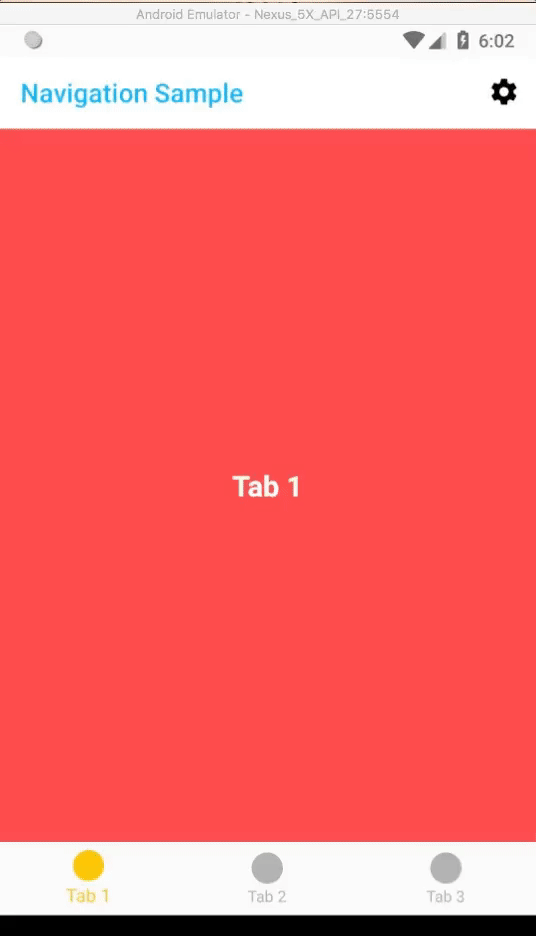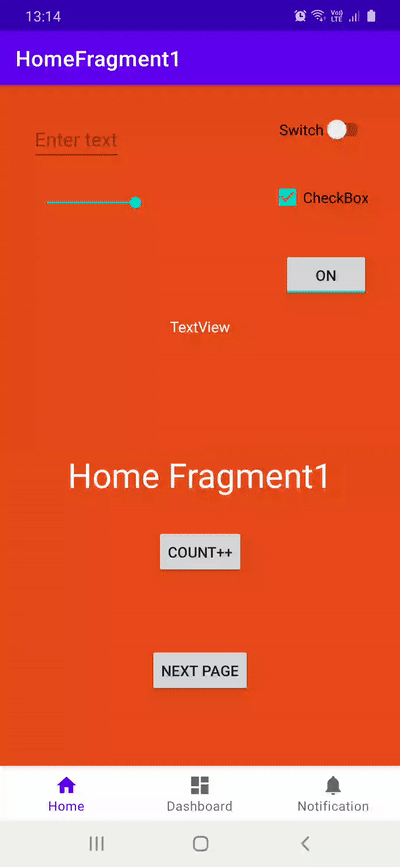The key point to have a proper back stack that keeps state's is to have NavHostFragment's which has childFragmentManager and their own backstack. Extension file of Navigation component's advanced sample actually does this.
/**
* Manages the various graphs needed for a [BottomNavigationView].
*
* This sample is a workaround until the Navigation Component supports multiple back stacks.
*/
fun BottomNavigationView.setupWithNavController(
navGraphIds: List<Int>,
fragmentManager: FragmentManager,
containerId: Int,
intent: Intent
): LiveData<NavController> {
// Map of tags
val graphIdToTagMap = SparseArray<String>()
// Result. Mutable live data with the selected controlled
val selectedNavController = MutableLiveData<NavController>()
var firstFragmentGraphId = 0
// First create a NavHostFragment for each NavGraph ID
navGraphIds.forEachIndexed { index, navGraphId ->
val fragmentTag = getFragmentTag(index)
// Find or create the Navigation host fragment
val navHostFragment = obtainNavHostFragment(
fragmentManager,
fragmentTag,
navGraphId,
containerId
)
// Obtain its id
val graphId = navHostFragment.navController.graph.id
if (index == 0) {
firstFragmentGraphId = graphId
}
// Save to the map
graphIdToTagMap[graphId] = fragmentTag
// Attach or detach nav host fragment depending on whether it's the selected item.
if (this.selectedItemId == graphId) {
// Update livedata with the selected graph
selectedNavController.value = navHostFragment.navController
attachNavHostFragment(fragmentManager, navHostFragment, index == 0)
} else {
detachNavHostFragment(fragmentManager, navHostFragment)
}
}
// Now connect selecting an item with swapping Fragments
var selectedItemTag = graphIdToTagMap[this.selectedItemId]
val firstFragmentTag = graphIdToTagMap[firstFragmentGraphId]
var isOnFirstFragment = selectedItemTag == firstFragmentTag
// When a navigation item is selected
setOnNavigationItemSelectedListener { item ->
// Don't do anything if the state is state has already been saved.
if (fragmentManager.isStateSaved) {
false
} else {
val newlySelectedItemTag = graphIdToTagMap[item.itemId]
if (selectedItemTag != newlySelectedItemTag) {
// Pop everything above the first fragment (the "fixed start destination")
fragmentManager.popBackStack(
firstFragmentTag,
FragmentManager.POP_BACK_STACK_INCLUSIVE
)
val selectedFragment = fragmentManager.findFragmentByTag(newlySelectedItemTag)
as NavHostFragment
// Exclude the first fragment tag because it's always in the back stack.
if (firstFragmentTag != newlySelectedItemTag) {
// Commit a transaction that cleans the back stack and adds the first fragment
// to it, creating the fixed started destination.
fragmentManager.beginTransaction()
.attach(selectedFragment)
.setPrimaryNavigationFragment(selectedFragment)
.apply {
// Detach all other Fragments
graphIdToTagMap.forEach { _, fragmentTagIter ->
if (fragmentTagIter != newlySelectedItemTag) {
detach(fragmentManager.findFragmentByTag(firstFragmentTag)!!)
}
}
}
.addToBackStack(firstFragmentTag)
.setCustomAnimations(
R.anim.nav_default_enter_anim,
R.anim.nav_default_exit_anim,
R.anim.nav_default_pop_enter_anim,
R.anim.nav_default_pop_exit_anim
)
.setReorderingAllowed(true)
.commit()
}
selectedItemTag = newlySelectedItemTag
isOnFirstFragment = selectedItemTag == firstFragmentTag
selectedNavController.value = selectedFragment.navController
true
} else {
false
}
}
}
// Optional: on item reselected, pop back stack to the destination of the graph
setupItemReselected(graphIdToTagMap, fragmentManager)
// Handle deep link
setupDeepLinks(navGraphIds, fragmentManager, containerId, intent)
// Finally, ensure that we update our BottomNavigationView when the back stack changes
fragmentManager.addOnBackStackChangedListener {
if (!isOnFirstFragment && !fragmentManager.isOnBackStack(firstFragmentTag)) {
this.selectedItemId = firstFragmentGraphId
}
// Reset the graph if the currentDestination is not valid (happens when the back
// stack is popped after using the back button).
selectedNavController.value?.let { controller ->
if (controller.currentDestination == null) {
controller.navigate(controller.graph.id)
}
}
}
return selectedNavController
}
private fun BottomNavigationView.setupDeepLinks(
navGraphIds: List<Int>,
fragmentManager: FragmentManager,
containerId: Int,
intent: Intent
) {
navGraphIds.forEachIndexed { index, navGraphId ->
val fragmentTag = getFragmentTag(index)
// Find or create the Navigation host fragment
val navHostFragment = obtainNavHostFragment(
fragmentManager,
fragmentTag,
navGraphId,
containerId
)
// Handle Intent
if (navHostFragment.navController.handleDeepLink(intent)
&& selectedItemId != navHostFragment.navController.graph.id
) {
this.selectedItemId = navHostFragment.navController.graph.id
}
}
}
private fun BottomNavigationView.setupItemReselected(
graphIdToTagMap: SparseArray<String>,
fragmentManager: FragmentManager
) {
setOnNavigationItemReselectedListener { item ->
val newlySelectedItemTag = graphIdToTagMap[item.itemId]
val selectedFragment = fragmentManager.findFragmentByTag(newlySelectedItemTag)
as NavHostFragment
val navController = selectedFragment.navController
// Pop the back stack to the start destination of the current navController graph
navController.popBackStack(
navController.graph.startDestination, false
)
}
}
private fun detachNavHostFragment(
fragmentManager: FragmentManager,
navHostFragment: NavHostFragment
) {
fragmentManager.beginTransaction()
.detach(navHostFragment)
.commitNow()
}
private fun attachNavHostFragment(
fragmentManager: FragmentManager,
navHostFragment: NavHostFragment,
isPrimaryNavFragment: Boolean
) {
fragmentManager.beginTransaction()
.attach(navHostFragment)
.apply {
if (isPrimaryNavFragment) {
setPrimaryNavigationFragment(navHostFragment)
}
}
.commitNow()
}
private fun obtainNavHostFragment(
fragmentManager: FragmentManager,
fragmentTag: String,
navGraphId: Int,
containerId: Int
): NavHostFragment {
// If the Nav Host fragment exists, return it
val existingFragment = fragmentManager.findFragmentByTag(fragmentTag) as NavHostFragment?
existingFragment?.let { return it }
// Otherwise, create it and return it.
val navHostFragment = NavHostFragment.create(navGraphId)
fragmentManager.beginTransaction()
.add(containerId, navHostFragment, fragmentTag)
.commitNow()
return navHostFragment
}
private fun FragmentManager.isOnBackStack(backStackName: String): Boolean {
val backStackCount = backStackEntryCount
for (index in 0 until backStackCount) {
if (getBackStackEntryAt(index).name == backStackName) {
return true
}
}
return false
}
private fun getFragmentTag(index: Int) = "bottomNavigation#$index"
Important part here is to obtain NavHostFragment if it does not exist in back stack with the function above and add it to back stack. commitNow is synchronous unlike commit
private fun obtainNavHostFragment(
fragmentManager: FragmentManager,
fragmentTag: String,
navGraphId: Int,
containerId: Int
): NavHostFragment {
// If the Nav Host fragment exists, return it
val existingFragment = fragmentManager.findFragmentByTag(fragmentTag) as NavHostFragment?
existingFragment?.let { return it }
// Otherwise, create it and return it.
val navHostFragment = NavHostFragment.create(navGraphId)
fragmentManager.beginTransaction()
.add(containerId, navHostFragment, fragmentTag)
.commitNow()
return navHostFragment
}
I built one using the NavigationExtension above which looks like this
![BottomNavigationView with Navigation Component]()
with nested navigation.
Navigation graphs are similar, so only i add one
nav_graph_home.xml
<?xml version="1.0" encoding="utf-8"?>
<navigation xmlns:android="http://schemas.android.com/apk/res/android"
xmlns:app="http://schemas.android.com/apk/res-auto"
xmlns:tools="http://schemas.android.com/tools"
android:id="@+id/nav_graph_home"
app:startDestination="@id/homeFragment1">
<fragment
android:id="@+id/homeFragment1"
android:name="com.smarttoolfactory.tutorial5_3navigationui_bottomnavigation_nestednavigation.blankfragment.HomeFragment1"
android:label="HomeFragment1"
tools:layout="@layout/fragment_home1">
<action
android:id="@+id/action_homeFragment1_to_homeFragment2"
app:destination="@id/homeFragment2" />
</fragment>
<fragment
android:id="@+id/homeFragment2"
android:name="com.smarttoolfactory.tutorial5_3navigationui_bottomnavigation_nestednavigation.blankfragment.HomeFragment2"
android:label="HomeFragment2"
tools:layout="@layout/fragment_home2">
<action
android:id="@+id/action_homeFragment2_to_homeFragment3"
app:destination="@id/homeFragment3" />
</fragment>
<fragment
android:id="@+id/homeFragment3"
android:name="com.smarttoolfactory.tutorial5_3navigationui_bottomnavigation_nestednavigation.blankfragment.HomeFragment3"
android:label="HomeFragment3"
tools:layout="@layout/fragment_home3" >
<action
android:id="@+id/action_homeFragment3_to_homeFragment1"
app:destination="@id/homeFragment1"
app:popUpTo="@id/homeFragment1"
app:popUpToInclusive="true" />
</fragment>
</navigation>
Menu for bottom navigation
menu_bottom_nav.xml
<?xml version="1.0" encoding="utf-8"?>
<menu xmlns:android="http://schemas.android.com/apk/res/android">
<item
android:id="@+id/nav_graph_home"
android:icon="@drawable/ic_baseline_home_24"
android:title="Home"/>
<item
android:id="@+id/nav_graph_dashboard"
android:icon="@drawable/ic_baseline_dashboard_24"
android:title="Dashboard"/>
<item
android:id="@+id/nav_graph_notification"
android:icon="@drawable/ic_baseline_notifications_24"
android:title="Notification"/>
</menu>
Layout for MainActivity that contains FragmentContainerView and BottomNavigationView
activiy_main.xml
<?xml version="1.0" encoding="utf-8"?>
<androidx.constraintlayout.widget.ConstraintLayout xmlns:android="http://schemas.android.com/apk/res/android"
xmlns:app="http://schemas.android.com/apk/res-auto"
xmlns:tools="http://schemas.android.com/tools"
android:layout_width="match_parent"
android:layout_height="match_parent"
tools:context=".MainActivity">
<androidx.fragment.app.FragmentContainerView
android:id="@+id/nav_host_container"
android:layout_width="0dp"
android:layout_height="0dp"
app:layout_constraintBottom_toTopOf="@+id/bottom_nav"
app:layout_constraintLeft_toLeftOf="parent"
app:layout_constraintRight_toRightOf="parent"
app:layout_constraintTop_toTopOf="parent" />
<com.google.android.material.bottomnavigation.BottomNavigationView
android:id="@+id/bottom_nav"
android:layout_width="match_parent"
android:layout_height="wrap_content"
app:layout_constraintBottom_toBottomOf="parent"
app:menu="@menu/menu_bottom_nav" />
</androidx.constraintlayout.widget.ConstraintLayout>
MainActivity.kt
class MainActivity : AppCompatActivity() {
private var currentNavController: LiveData<NavController>? = null
override fun onCreate(savedInstanceState: Bundle?) {
super.onCreate(savedInstanceState)
setContentView(R.layout.activity_main)
supportFragmentManager.addOnBackStackChangedListener {
val backStackEntryCount = supportFragmentManager.backStackEntryCount
val fragments = supportFragmentManager.fragments
val fragmentCount = fragments.size
Toast.makeText(
this,
"MainActivity backStackEntryCount: $backStackEntryCount, fragmentCount: $fragmentCount, fragments: $fragments",
Toast.LENGTH_SHORT
).show()
}
if (savedInstanceState == null) {
setupBottomNavigationBar()
} // Else, need to wait for onRestoreInstanceState
}
override fun onRestoreInstanceState(savedInstanceState: Bundle?) {
super.onRestoreInstanceState(savedInstanceState)
// Now that BottomNavigationBar has restored its instance state
// and its selectedItemId, we can proceed with setting up the
// BottomNavigationBar with Navigation
setupBottomNavigationBar()
}
/**
* Called on first creation and when restoring state.
*/
private fun setupBottomNavigationBar() {
val bottomNavigationView = findViewById<BottomNavigationView>(R.id.bottom_nav)
val navGraphIds = listOf(
R.navigation.nav_graph_home,
R.navigation.nav_graph_dashboard,
R.navigation.nav_graph_notification
)
// Setup the bottom navigation view with a list of navigation graphs
val controller = bottomNavigationView.setupWithNavController(
navGraphIds = navGraphIds,
fragmentManager = supportFragmentManager,
containerId = R.id.nav_host_container,
intent = intent
)
// Whenever the selected controller changes, setup the action bar.
controller.observe(this, Observer { navController ->
setupActionBarWithNavController(navController)
})
currentNavController = controller
}
override fun onSupportNavigateUp(): Boolean {
return currentNavController?.value?.navigateUp() ?: false
}
}
Fragment layouts and classes are simple classes so i skipped them out.You can check out full sample i built, or Google's repository to examine extension for advanced navigation or or other samples.




popBackStackis called from theNavController.navigate()function whenNavOptionsare not null. My guess is that at the moment it is not possible to do it out of the box. A custom implementation of NavController is required that accesses themBackStackthrough reflection or something like that. – Aldinif (!navHost.popBackStack(it.itemId, false)) navHost.navigate(it.itemId)– Reviviscence